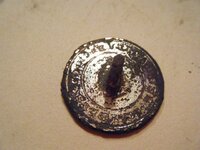cti4sw
Bronze Member
- Jul 2, 2012
- 1,555
- 919
- 🥇 Banner finds
- 1
- Detector(s) used
- Minelab Equinox 600, Garrett AT Pro, Pro Pointer
- Primary Interest:
- Relic Hunting
Got a one-piece flat button here, plain front, 18.2mm diameter. For all that it's a great phone camera, the Galaxy 4 cannot focus on small details.

Reverse has two lines:
(1) * T _ _ E L _ S I _ T * WARRANTED (letters are guesstimated)
(2) STAND GOLD _ ("GOLD" could be "COLOU")
From under the microscope:


The first pic you can clearly see the WARRANTED. In the second, the TREBLE is much clearer.


Between these two pics, the GILT and STAND : COLOUR is much more defined.
God, I love this scope.
EDIT: Got another one for you to look at. This one is tiny, gonna say 12-13mm, with lettering on the back. Here are the scope pics:





Reverse has two lines:
(1) * T _ _ E L _ S I _ T * WARRANTED (letters are guesstimated)
(2) STAND GOLD _ ("GOLD" could be "COLOU")
From under the microscope:


The first pic you can clearly see the WARRANTED. In the second, the TREBLE is much clearer.


Between these two pics, the GILT and STAND : COLOUR is much more defined.
God, I love this scope.
EDIT: Got another one for you to look at. This one is tiny, gonna say 12-13mm, with lettering on the back. Here are the scope pics:




Amazon Forum Fav 👍
Last edited:


 Still trying though. The pic of below is the first few hours in one of them.
Still trying though. The pic of below is the first few hours in one of them.




